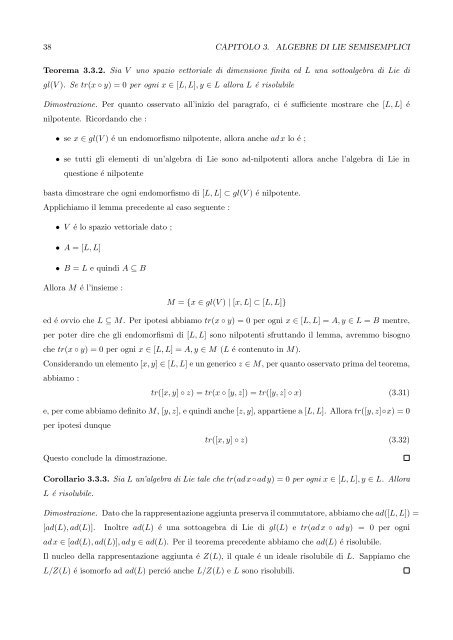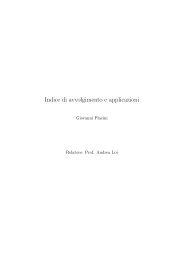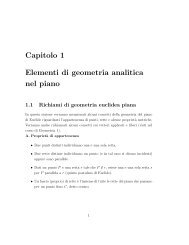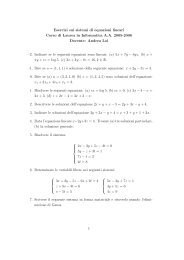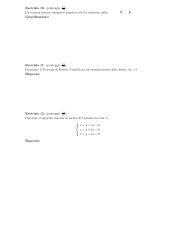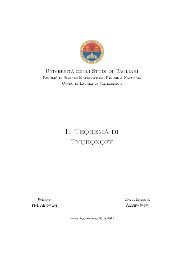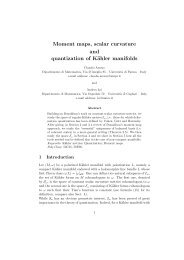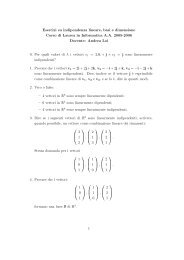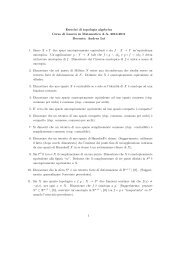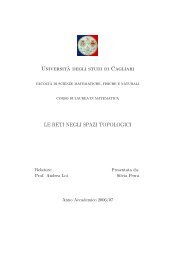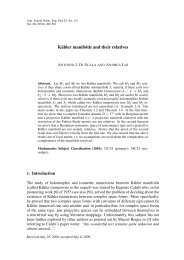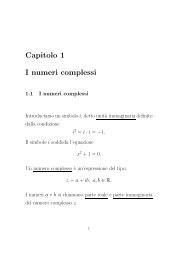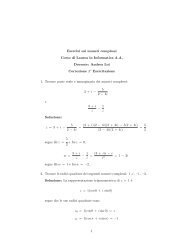Algebre di Lie semisemplici, sistemi di radici e loro classificazione
Algebre di Lie semisemplici, sistemi di radici e loro classificazione
Algebre di Lie semisemplici, sistemi di radici e loro classificazione
You also want an ePaper? Increase the reach of your titles
YUMPU automatically turns print PDFs into web optimized ePapers that Google loves.
38 CAPITOLO 3. ALGEBRE DI LIE SEMISEMPLICI<br />
Teorema 3.3.2. Sia V uno spazio vettoriale <strong>di</strong> <strong>di</strong>mensione finita ed L una sottoalgebra <strong>di</strong> <strong>Lie</strong> <strong>di</strong><br />
gl(V ). Se tr(x ◦ y) = 0 per ogni x ∈ [L, L], y ∈ L allora L é risolubile<br />
Dimostrazione. Per quanto osservato all’inizio del paragrafo, ci é sufficiente mostrare che [L, L] é<br />
nilpotente. Ricordando che :<br />
• se x ∈ gl(V ) é un endomorfismo nilpotente, allora anche ad x lo é ;<br />
• se tutti gli elementi <strong>di</strong> un’algebra <strong>di</strong> <strong>Lie</strong> sono ad-nilpotenti allora anche l’algebra <strong>di</strong> <strong>Lie</strong> in<br />
questione é nilpotente<br />
basta <strong>di</strong>mostrare che ogni endomorfismo <strong>di</strong> [L, L] ⊂ gl(V ) é nilpotente.<br />
Applichiamo il lemma precedente al caso seguente :<br />
• V é lo spazio vettoriale dato ;<br />
• A = [L, L]<br />
• B = L e quin<strong>di</strong> A ⊆ B<br />
Allora M é l’insieme :<br />
M = {x ∈ gl(V ) | [x, L] ⊂ [L, L]}<br />
ed é ovvio che L ⊆ M. Per ipotesi abbiamo tr(x ◦ y) = 0 per ogni x ∈ [L, L] = A, y ∈ L = B mentre,<br />
per poter <strong>di</strong>re che gli endomorfismi <strong>di</strong> [L, L] sono nilpotenti sfruttando il lemma, avremmo bisogno<br />
che tr(x ◦ y) = 0 per ogni x ∈ [L, L] = A, y ∈ M (L é contenuto in M).<br />
Considerando un elemento [x, y] ∈ [L, L] e un generico z ∈ M, per quanto osservato prima del teorema,<br />
abbiamo :<br />
tr([x, y] ◦ z) = tr(x ◦ [y, z]) = tr([y, z] ◦ x) (3.31)<br />
e, per come abbiamo definito M, [y, z], e quin<strong>di</strong> anche [z, y], appartiene a [L, L]. Allora tr([y, z]◦x) = 0<br />
per ipotesi dunque<br />
Questo conclude la <strong>di</strong>mostrazione.<br />
tr([x, y] ◦ z) (3.32)<br />
Corollario 3.3.3. Sia L un’algebra <strong>di</strong> <strong>Lie</strong> tale che tr(ad x◦ad y) = 0 per ogni x ∈ [L, L], y ∈ L. Allora<br />
L é risolubile.<br />
Dimostrazione. Dato che la rappresentazione aggiunta preserva il commutatore, abbiamo che ad([L, L]) =<br />
[ad(L), ad(L)]. Inoltre ad(L) é una sottoagebra <strong>di</strong> <strong>Lie</strong> <strong>di</strong> gl(L) e tr(ad x ◦ ad y) = 0 per ogni<br />
ad x ∈ [ad(L), ad(L)], ad y ∈ ad(L). Per il teorema precedente abbiamo che ad(L) é risolubile.<br />
Il nucleo della rappresentazione aggiunta é Z(L), il quale é un ideale risolubile <strong>di</strong> L. Sappiamo che<br />
L/Z(L) é isomorfo ad ad(L) perció anche L/Z(L) e L sono risolubili.


